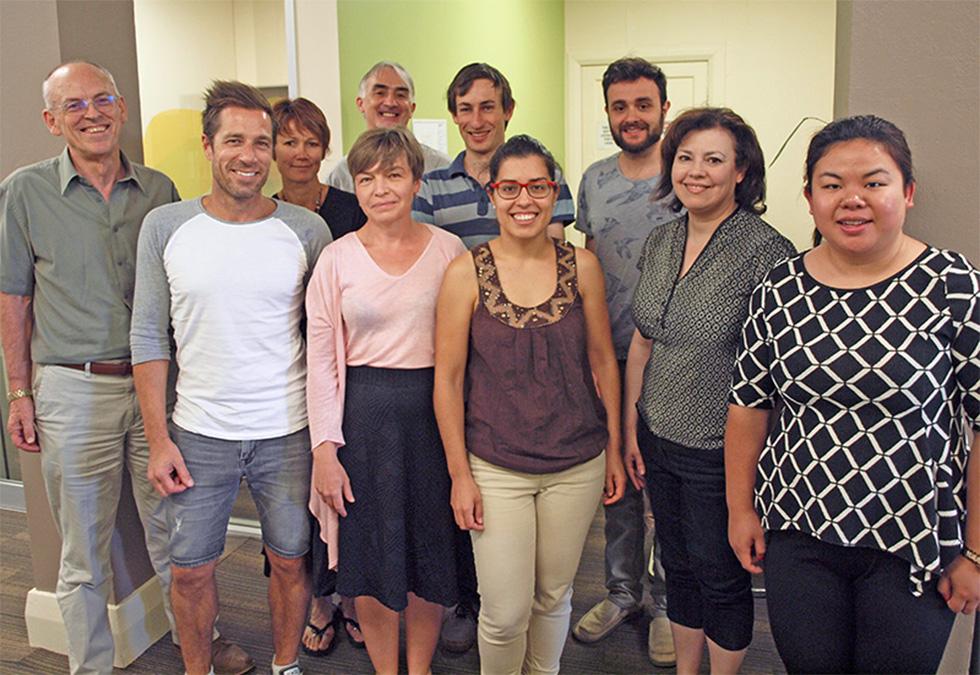Statistics investment to underpin southern grains research advances

Members of the SAGI South team include (front from left): Richard Jarrett, Julian Taylor, Olena Kravchuk, Sabela Munoz Santa, Helena Oakey, Wendy Li (rear from left): Bev Gogel, Andy Timmins, Sam Rogers, Chris De Ieso. Absent: Sharon Nielsen, Lachlan Mitchell and Peter Kasprzak.
The Grains Research and Development Corporation (GRDC) has announced a major new investment aimed at strengthening and enhancing national and regional grains research outcomes.
The GRDC has launched phase three of its Statistics for the Australian Grains Industry (SAGI) program which will involve the creation of four nodes across Australia to deliver an unprecedented level of high quality statistical science to underpin the scientific rigour of hundreds of research projects.
GRDC Managing Director Dr Steve Jefferies says the SAGI-3 investment of $18 million over the next five years will be essential in supporting rapid advances in crop varieties, agronomic knowledge and farming practices – ultimately contributing to enduring profitability for Australian grain growers.
“This significant investment will increase the national grains industry’s capacity in the area of biometrics – the application of statistics to biological data – which is incredibly important in ensuring that grains research is statistically sound and credible, as well as speeding up research outcomes for the benefit of growers,” Dr Jefferies said.
Each of the regional SAGI Nodes (South, North and West) will provide support for trial design and data analysis for projects relevant to their regions – these are projects developed as part of GRDC’s Grower and Applied R&D business groups.
The regional nodes will also be responsible for providing statistical training and support for regional agronomists, providing training, mentoring and statistical research collaborative support to researchers, and training a new generation of highly-skilled biometricians.
SAGI-South based at the Waite campus
SAGI South will be led by the University of Adelaide, with co-investment from the University and the South Australian Research and Development Institute.
The SAGI South project leader is senior statistician Dr Olena Kravchuk of the University’s School of Agriculture, Food and Wine at the Waite campus. She says the GRDC’s investment in SAGI-3 will have a broad beneficial impact on grains research.
“As well as boosting the biometry expertise and capability at the Waite campus, we will be working closely with researchers throughout the southern region (SA, Victoria and Tasmania) as our capacity permits and building productive relationships with agronomists and growers across the south,” Dr Kravchuk said.
Supported by a team of 12 statisticians and data scientists – including lead researchers Dr Julian Taylor, Dr Helena Oakey, Dr Beverley Gogel and Dr Andy Timmins – Dr Kravchuk says SAGI South will provide statistical methodology to grains research projects in the region and lead capacity building in experimental design and analysis skills in the southern grains industry through academic courses, tailored professional development workshops and internship programs.
“We will also promote the adoption of efficient statistical methodologies through developing and making available user-oriented online applications.
“As well, SAGI South will be advancing statistical methodologies in plant genetics, statistical computing and comparative agricultural experiments through our statistical research, supervision of graduate students and national and international collaborations with leading statistical and bio-research groups and Australian and international statistical societies,” Dr Kravchuk said.
The SAGI southern node will be closely linked to the northern (led by the Queensland Department of Agriculture and Fisheries) and western (based at Curtin University) nodes and to the national node (based at the University of Wollongong) through training and research initiatives, as well as collaborative projects.
About this article
The original article was published by the GRDC.
